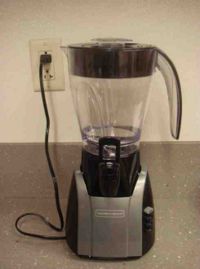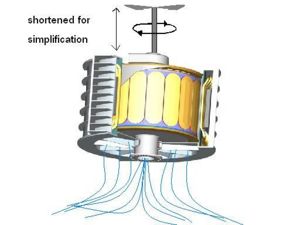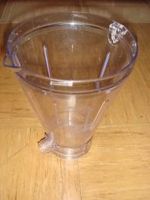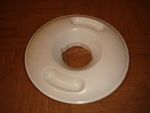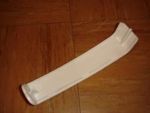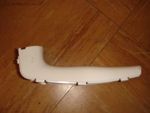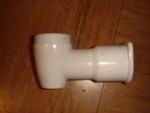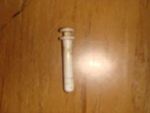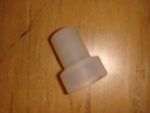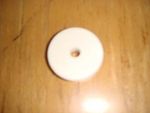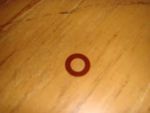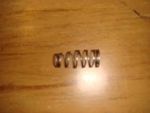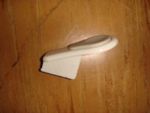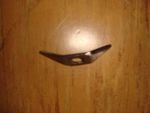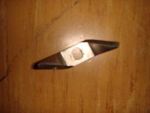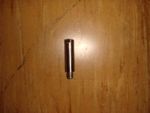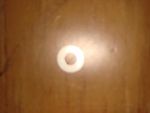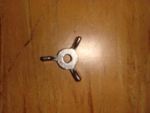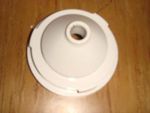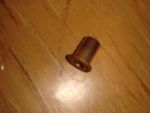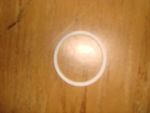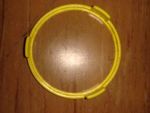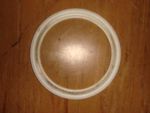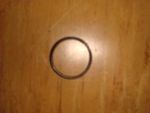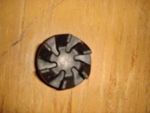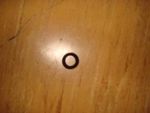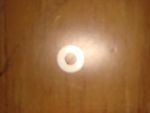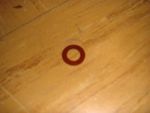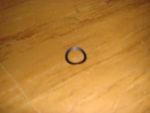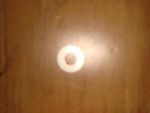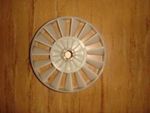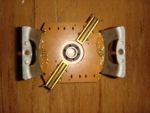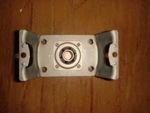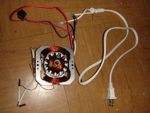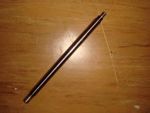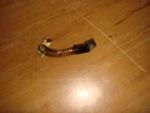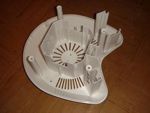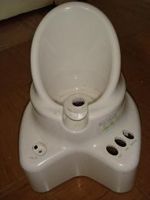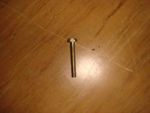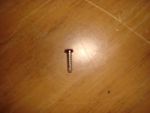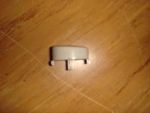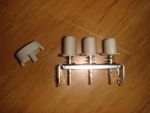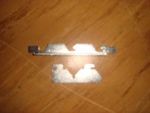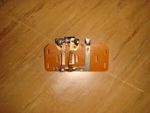Blender
From DDL Wiki
Contents |
Executive Summary
The Back To Basics Smoothie Maker is a blender that serves numerous functions. It blends various products including frozen drinks, is lightweight, easily accessible and can be used in both house and restaurant settings. The inputs of the blender are AC current from a wall socket and the ingredients needed to mix a desired product. A user's ingredients may include batter, spreads or smoothie mixes. The outputs are a rotating blade, rotating at a chosen speed by the user, and the desired product that will be served.
To develop a new product that will be appealing to consumers we analyzed a highly-used kitchen appliance that will better fit our customer's needs. We analyzed this product using various tools such as a product dissection, DFMA, DFE, FMEA. We also investigated the many product uses and customer needs. While studying this product we discovered that there are many design flaws that can be improved.
From the product dissection we were able to conclude that there is little room for improvement in Design for Manufacture and Assembly. Many of the parts were composed of plastic that was manufactured through injection molding, which is cheap and quick. And parts are easily assembled through snap on fits. However, it was noted that there was a couple of parts glued together, which may lead to issues that if designed around could save a significant amount of time and money.
Examining how the product affects the environment, through Design for the Environment, we were able to determine that although there is some affect, it is minimal and would be difficult to improve upon. After composing a Failure Modes and Effects Analysis, it was determined that there are several issues that could be dealt with to reduce the occurrence, detectability, and the severity of such failures. These failures ranged from things that would disable the blender entirely, to cracks in components. Concluding the analysis was the mechanical analysis of the product which investigated heat transfer. It was determined that the heat that would be created as a result of the motor, would not affect the temperature of the items being blended by a significant amount.
Major Customer Needs
When examining a blender, it becomes quite obvious that the purpose of the blender is to mix ingredients together to form a new item. Often times liquids and solids will be mixed together, for example a milkshake involves mixing milk and ice cream. Often times blenders are used for health and age purposes, such as protein shakes and various other similar products. Blendertec is a great resource for recipes specific to a blender. The way the goal is accomplished is by spinning several blades, at high enough speeds to both grind up solids, and to spin fluids quick enough to create an even mix. This is not always easy because different desired outputs will require different speeds to create a good mix. Generally a blender will provide several speed settings. These settings are to provide for a variety of outputs. While it would seem that the main use of a blender is to make frozen beverages such as milkshakes, smoothies, and various frozen alcoholic beverages, there are many other products that the blender is used to create. These includes batters, such as cake and pancake batters, sauces, dips, dressings, various spreads, soups, syrups, and mixing juices.
For smoothe, well mixed products, it becomes necessary that the blender will be able to spin at a variety of speeds to evenly mix all of the ingredients within. It is known to be a hassle when some of the final product comes out as intended, and the rest is still chunky and uneven. This requires a second term of mixing. Without speeds settings, it is more necessary that the user decide when it is at the proper composition, and this provides for greater user error. In similarity with this issue, it is common that ice and unmixed ingredients can tend to float at the surface and will not be pulled down into the blades to be chopped up. This causes uneven compositions and often times one will have to reblend the items. Another customer need, is that the blender be easily stored. It is not very common that one would use a blender on a very regular basis, so it would be beneficial that it could be stored away in a drawer or cabinet. As is the case for most products, it is also recommended that the blender be durable and able to last a long time, even when mistakes occur, such as dropping it and mixing hard items. An important consideration for blenders is their volume. Because the blades are spinning at high speeds, and chopping up hard ingredients, blenders tend to be quite loud. This is a major area of concern because often times blenders are used in restaurants and the restaurant would not want to distract their customers. This can also be an inconvenience to a regular user especially if they were to have company. While it may not always be considered, cleaning is an important aspect to product use. For a blender, cleaning can be a huge hassle to someone who does not have a dishwasher. The pitcher is concically shaped and with blades at the bottom, it can be very difficult to properly clean the insider after use. As is the case for all products, safety is very important. It is assumed that the blender be safe, and this takes into account the fact that there are blades spinning at very high speeds. It is important to the customer that the blender be safe and durable over a long time, and so parts must be secured very strongly.
The design of a blender should allow for the product to be beneficial over similar products. While there are many tools that exist that can spin to mix foods, a blender should allow for a similar task while holding its contents into some provided volume container. The blender should have a variety of speeds, and be able to exert enough torque to blend a variety of food and drink items of different compositions. In order to make these abilities useful to an ordinary customer, markings and labels should be available to determine the appropriate setting. In a similar fashion, the container should be labeled so as to ensure the appropriate volume of food/fluid items. These are some of the design considerations that are important to customers for use.
Product Use
First, the consumer must remove the blender from the box and plug it in to a 120V wall socket(1). The consumer must then assemble it by placing the lid on the pitcher, the nozzle on the bottom, and attach the pitcher to the blade turner. These simple steps are straightforward and not difficult to do. The pitcher can only fit in to the base one way because of the grooves and the markings(2). This makes it easier for the consumer to place the blender in to the base.
The consumer would then fill the pitcher with whatever they would like to blend before adjusting the speed. There are three options: smooth, mix, and pulse(3). These basic descriptions for the speeds are clear and easy to understand. "Smooth" could be perceived as blending something thoroughly therefore it is the higher speed of the two locking buttons. Mix is slower and could be perceived as more stirring. Pulse can be used to intermittently blend the contents of the pitcher at a highest speed. The pulse button is the only button that does not lock. The other two pop up as soon as another has been pressed. When using the blender, a hand must hold the top down so as not to have the contents go flying everywhere. Trying to keep your hand on the top of the blender while pushing the buttons can lead to some difficulty(4). To pour, the consumer removes the top of the blender and grasps it by the handle or the grooves. To store the blender, unplug it and clean thoroughly.
To clean, the consumer takes apart the blender by removing the pitcher from the blade holder by twisting(5). This is usually kept tight so that liquid does not leak out the bottom therefore it is difficult to remove. Once the base is screwed off, the blades are easy to access. The nozzle must have water passed through to clean thoroughly but it is not intuitive how to screw the nozzle apart.
| 1 | 2 | 3 | 4 | 5 |
|---|---|---|---|---|
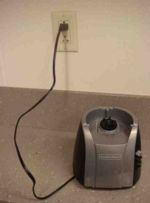 | 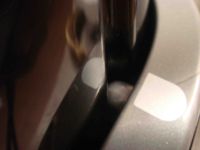 | 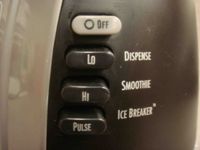 | 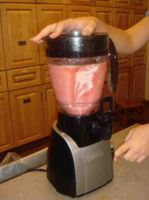 | 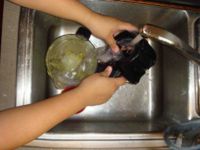
|
How System Functions
The system begins with the power of the motor. The motor works as all other motors whereas it converts electrical energy to mechanical energy. It fits snug under the base of the blender and is close to the blades of the blender. The idea of the motor relies on magnetism where one of the two main parts, the rotor, rotates due to a torque caused by the wires and magnetic field configuration. A voltage is applied to the lead battery wires originating from the AC plug that takes power from the wall socket. Along the shaft is the armature which is a set of electromagnets. This set up of magnets is constantly in rotation due to the opposite attraction of the magnetic field from the larger magnet and the wires around the armature. Electron flow changes constantly to allow for the constant rotation and magnetic flow. This axis is then attached through the motor box up until the opening of the blender. This rotation becomes transferred into the shaft of the blender axis. This same axis is connected to the two blades which are the tools necessary for the blending action. In order to allow for different blending speeds the user has different button options in which only one button can be chosen at a time.
To allow for various speeds, there exists an interesting button configuration. To allow for the three various speed settings, there needs to be some method to send different signals to the motor. The way this is done is first the method that allows for only one button to be pushed at a time. This is done via the button brackets. The buttons are attached to springs which are to be compressed. The metal shaft of each button has notches that indent out of the bottom to the sides. When compressed, these notches will slide along the button bracket slopes, which can be seen in the picture, until it reaches a point where it will lock down. This position works because the spring is causing an upwards force, which is countered by the force of the bracket being on top of it. When another button is pressed, the second bracket, which is also slopped, causes a vertical and horizontal force, causing the first bracket to slide to the side as well. This disables the lock on the previous button that was pressed. By this method only one button can be in utilization at a time.
The way that the signal is sent from the compressed buttons, is that when the button is down, a part on the signal transmitter is also pushed down creating a connection in the circuit. The speed settings connect the same circuit; however the strength of signal is controlled by using a capacitor, which limits the strength of one of the signals, while the other is uninhibited. With this configuration, speed can easily be controlled.
Connected to the axis as well is a fan pointed towards the bottom of the base. There are slits at the bottom of the base that allows for the heat to be sent away from the blender. Since the blender sits on four legs there is more ability for air movement.
http://electronics.howstuffworks.com/motor.htm
Product Disassembly
Design for Manufacture and Assembly
The current product is composed of 4 major components: the pitcher, motor, base, and operator control.
Most of the pitcher is made of plastic and is made by injection modling. The subparts of the pitcher are assembled with the use of fasteners. The way the parts of the pitcher are assembled is by fasteners and clips which increases the ease of assembly. There is a blade holder assembly at the base of the plastic pitcher. This piece is plastic and is used to attach the pitcher to the base of the blender. The design for the shape of the pitcher is developed so that appropriate liquid flow will aid in a more consistent mix while blending.
This blender blade fixture is also plastic but needs to be bored out with a drill through the middle forming an area for a long screw from the blade assembly. The production of the blades is from a slab of metal where slices of equivalent sizes are taken in order to produce mass amounts of blades at one time. This is a helpful design decision that aides in the efficiency and productivity of the mechanical process. The blender blade setup uses two identical blades 90 degrees to each other that sit on top of one another that are kept in place with simple washers and a long screw.
The second major component is the motor which is hidden inside the base and directly under the pitcher. The motor is from a specialized motor company. The problem of heat transfer must be examined to make sure the heat produced from the motor will not melt the parts nearby. The motor is made to fit under the base and is sufficiently mounted. The mounting clips are under the blender base and are made to withstand the movement associated with the vibrations from the motor. The mounting clips are extensions on the base allowing for more strength. However, many parts of the motor attachment are attached by gluing which may result in problems with reusing or taking apart the glued components during the assembly process.
The third main component is the base. It is made of plastic and is mass produced most likely by injection molding. The base is made durable enough to withstand added liquid in the pitcher as well as a running motor.
The last component is the operator control that allows the user to choose different blending speeds. This set up harnesses the electrical wiring component of the blender. Wiring placement is important because the ability for wet liquids to dispel around or near the harness could lead to extreme danger or malfunction. The wiring is designed far from the liquid contents of the blender and the wiring is sealed to maintain a cooler operating temperature as well as to keep the wires dry. A design flaw of the wiring is that the wires are bunched towards the walls of the blender base. It is a manual job to bunch the wiring and slows the overall assembly process. Also, the buttons for the user input are assembled with snap on fittings and the metal wiring attachments to the buttons are made with metal press and fittings.
The blender actually consisted of over 50 components. Although we only mentioned the 4 main parts of the blender assembly, the actual manufacturing process was actually very difficult and time consuming due to the mass amount of components and attachments. The future design for the blender would most definitely need to reduce the amount of components to speed up the rate of the manufacturing process.
Design for the Environment
With the research that we’ve done so far, we have found five strategies that if improved, could decrease the impact our product has on the environment. The major concerns include, but are not limited to, new concept development, low impact materials, manufacturing, maximizing first life, and end of life.
New Concept Development - By integrating several other functions in to the blender, it could reduce the need for other appliances within the kitchen. It’s current design featuring the nozzle at the base of the blender allows users to use the blender as both a blender and a pitcher.
Low Impact Materials – The majority of the parts of the blender are plastic. The type of plastic effects the environmental impact therefore we assumed that most of the parts in the blender were made out of PVC. The end of life reusable parts of the blender could be high as there are several models of blenders that use the same parts however there aren't currently specific blender recycling locations. The PVC can therefore be recycled chemically or mechanically; mechanically it would be ground up and new objects can be made from the new material or chemically where it would be heated so that the polymers themselves would break down.
Manufacturing – Further research should be done in to the manufacturing processes and perhaps there could be a reduction in the amount of waste materials. Most of the plastic looks as though it was made through injection molding (flashing lines are indicative of this type of manufacturing). This process results in less waste material and is fairly accurate, keeping defects to a low.
Maximizing First Life – Clearer instructions on disassembly and cleaning could help decrease the possibility of breaking the blender while trying to do either. Breaking could lead the need to replace multiple parts and damaging the environment further.
End of Life – The motor of the blender could be recycled as well as the plastic.
LCA
The Economic Input/Output Life Cycle Assessment has information on the estimated overall environmental impact, including greenhouse gases, energy usage, and toxic releases. The blender falls under "Electric housewares and household fan manufacturing." We ran the model with an economic activity of $1 million and analyzed both the energy usage as well as the greenhouse emissions. The following table displays the energy usage calculations:
| Sector | Total TJ | Elec MkWh | Coal TJ | NatGas TJ | LPG TJ | MotGas TJ | Distillate TJ | JetFuel TJ | Residual TJ |
|---|---|---|---|---|---|---|---|---|---|
| Total for all sectors | 8.62 | 0.503 | 2.37 | 3.64 | 0.235 | 0.560 | 0.809 | 0.194 | 0.245 |
| Power generation and supply | 2.58 | 0.000 | 2.04 | 0.457 | 0.000 | 0.000 | 0.000 | 0 | 0.078 |
| Electric housewares and household fan manufacturing | 1.11 | 0.130 | 0 | 0.599 | 0.008 | 0.301 | 0.049 | 0 | 0.006 |
| Iron and steel mills | 0.733 | 0.036 | 0.034 | 0.632 | 0.002 | 0.005 | 0.004 | 0.000 | 0.024 |
| Truck transportation | 0.415 | 0.001 | 0 | 0.009 | 0.001 | 0.060 | 0.343 | 0 | 0 |
| Plastics material and resin manufacturing | 0.320 | 0.018 | 0.021 | 0.258 | 0.015 | 0.004 | 0.001 | 0 | 0.002 |
The greenhouse emissions caused by the manufacturing of electric housewares such as a blender are below as well as the cost of power generation and supply and transportation. Below are the results:
| Sector | GWP MTCO2E | CO2 MTCO2E | CH4 MTCO2E | N2O MTCO2E | CFCs MTCO2E |
|---|---|---|---|---|---|
| Total for all sectors | 693 | 598 | 54.1 | 10.7 | 30.5 |
| Power generation and supply | 218 | 215 | 0 | 0 | 2.62 |
| Waste management and remediation services | 22.7 | 3.58 | 19.1 | 0.028 | 0 |
| Truck transportation | 57.9 | 57.0 | 0.088 | 0.796 | 0 |
| Iron and steel mills | 57.9 | 57.9 | 0 | 0 | 0 |
| Electric housewares and household fan manufacturing | 53.5 | 53.5 | 0 | 0 | 0 |
From this analysis, the overall environmental impact during use of a blender is much less than the manufacturing and transportation costs. A regular customer is consuming electricity while using the blender and it emits a negligible amount of heat and noise energy when considering the whole environment. Therefore, decreasing the environmental impact should be focused on manufacturing processes and decreasing the amount of natural gas used as its the area with the greatest amount of energy consumed.
Failure Mode Effects and Analysis
The following chart represents the failure modes that have been agreed upon as the greatest possible failures of the blender. The purpose of a Failure Mode Effects and Analysis chart is to assess the risks involved in the process of using a product, and to determine the importance to deal with each mode of failure. This is done by estimating a value that will indicate the severity, occurance, and detection of each error, and multiplying the values together. In order to deal with these issues, the chart then offers a possible action to solve the error, and will again account for the severity, occurance, and detection. By this way, one can see how effective the improvement is.
In our case, we have investigated and evaluated the possible failure modes associated with our product, the blender.
| Item & Function | Failure Mode | Effects of Failure | S | Causes of Failure | O | Design Controls | D | RPN | Recommended Actions | Responsibility & Deadline | Actions Taken | S* | O* | D* | RPN* |
|---|---|---|---|---|---|---|---|---|---|---|---|---|---|---|---|
Motor
| Motor overheating | Motor will not be able to turn the blades and would make blender useless. | 8 | Motor could overheat if left on too long when trying to blend foods of a harder consistency | 6 | Testing fan output that assists in cooling motor, as well as testing motor at max speeds with a variety of loads. | 8 | 384 | Incorporate a switch in that would shut the blender off if the torque approached it failure point. | Manufacturer of Motor | N/A | 8 | 2 | 8 | 128 |
Blade
| Blade edge dulls | It will take longer to mix and smooth as well as making it more diffcult to break apart certain items. | 3 | Overuse and attempting to break apart dense, hard items. | 5 | Test blade with items of a variety of densities and composures. | 2 | 30 | Find an appropriate material, thickness, and angle that will be least likely to dull. | N/A | N/A | 3 | 2 | 3 | 18 |
Pitcher
| Plastic cracks | Items being blended will leak out side of blender. | 4 | Dropped from a high height. | 7 | Test stress on blender when dropped. | 3 | 84 | Test different shapes and wall thicknesses to find a contaner least likely to break. | N/A | N/A | 3 | 4 | 3 | 36 |
Handle
| Breaks off | No handle to carry blender. | 3 | Dropped from a high height. | 7 | Test snap together fits to identify breaking points. | 2 | 42 | Test other ways to fit parts together to find most cost effective solution | Assembler | N/A | 3 | 3 | 3 | 27 |
Motor Coupling
| Uncouples | Blade will not spin even while motor does. | 8 | Motor spins incorrect direction. | 2 | Test possible ways that would cause motor to spin in wrong direction. | 8 | 128 | Find a controller or switch that would deactivate motor if it were to start spinning in wrong direction. | Manufacturer | N/A | 8 | 1 | 7 | 56 |
Wiring
| Wire becomes disconnected | Current will be unable to power motor or similar function. | 8 | Wire tangled with moving parts. | 2 | Test different fastners to hold wire parts. | 3 | 48 | Test different positions for wire to be fastened to reduce tangling. | Assembler | N/A | 8 | 1 | 2 | 16 |
Upon examining the FMEA for the blender, it can be observed that the failures include issues that would make the product unable to be used entirely, and also ones in which it just becomes more of an inconvience to the consumer. Both issues are important to consider, and the difference in importance can be noted from the values in the chart. Malfunction of the motor, coupling, and wiring would disable use of the blender entirely, while cracks in other components are not as significant. Examining the values in the chart for the motor overheating, it is obvious that it is a very severe issue, resulting in a 9, however it is not all that likely to occur explaining the 6 for occurance. A part such as the motor that is not easily accesible to the user, makes it difficult to detect the failure. This is an example that justifies the method used to determine our values. These failure modes are often best dealt with by conducting tests to find the best way to create a product that is both cost effective and satisfies the user.
Mechanical Analysis
If one is blending the contents of a blender for one minute what is the change in temperature of the blender contents? Based on the assumptions below and using the energy balance equation we can solve for the change in temperature.
Assumptions:
1. Objects, liquids or frozen fruits added to blender are all at 0 degrees Celsius
2. Final temperature of the contents of the blender is unknown
3. Mass and specific heat of contents in blender is equal to that of H20
4. Only 30% of Power from motor is being converted into rotation of blades
5. Contents in blender total to 1000mL
Equations Used:
Using the 1st law of thermodynamics (Energy balance equation)
Q - W = ΔE
Using the energy conservation term for heat:
Q = (mass)*(specific heat)*(change in Temp) = mCpΔT
mCpΔT – W = ΔE
Definitions:
Q = heat
W = work done by the system
ΔE = change in energy
ρ = density
m1 = mass of blender contents
Cp = specific heat of blender contents
ΔT = change in temperature of blender contents
Calculations/Solution:
ρH20 (ice) = .92g/mL
m1 = 1000mL *.92g/mL = 9200 g ice
Cp H20 = 2111.4J/(kg*K)
mCpΔT = 9.2kg *2111 .4J/(kg*K)*ΔT = 19,424.88* ΔT
W = .3(500W) = 150J/sec*(60sec) = 9000J
ΔE = 0 because there is no change in velocity of the rotating blades
mCpΔT = W => ΔT = 9000J/19,424.88 = .463323C
Answer: The final change in temperature is .46C.
This change in temperature is not a large amount. Therefore while blending, the user should not worry about the overall temperature of the contents becoming significantly lower due to the rotating blades.
